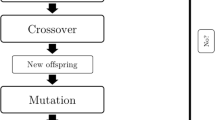Abstract
Computer-aided design of optical lens systems implies the solution of an optimization problem of large dimension. To apply a local algorithm, we want to know a starting point within a small neighborhood of the desired system. For a given task, the designer is not able to define a suitable starting point. In this paper, we describe a global optimization algorithm which uses the principles of biological evolution with the aim of locating an adequate starting point for a local correction routine.
Similar content being viewed by others
References
Loesche, K., Elsner, G., andNiklaus, J.,Rechnergestützte Optikmodellierung, Wissenschaftliche Zeitschrift der Friedrich Schiller Universität, Vol. 6, pp. 97–100, 1985.
Spendley, W., Hext, G. R., andHimsworth, F. R.,Sequential Application of Simplex Designs in Optimization and Evolutionary Operation, Technometrics, Vol. 4, pp. 441–459, 1962.
Box, M. I.,A New Method of Constrained Optimization and Comparison with Other Methods, Computer Journal, Vol. 8, pp. 42–52, 1965.
Nelder, I. A., andMead, R.,A Simplex Method for Function Minimization, Computer Journal, Vol. 7, pp. 308–313, 1965.
Dixon, L. C. W.,ACSIM: An Accelerated Constrained Simplex Technique, Computer Aided Design, Vol. 5, pp. 22–32, 1973.
Siegert, H. D.,Optimierung Optischer Systeme mit einem Simplexverfahren zur Funktionenminimierung. Friedrich Schiller University, Jena, PhD Thesis, 1981.
Rechenberg, I.,Optimierung Technischer Systeme nach Prinzipien der Biologischen Evolution, Frommann-Holzboog, Stuttgart, Germany, 1973.
Schwefel, H. P.,Numerische Optimierung von Computermodellen mittels Evolutionsstrategie, Birkhäuser Verlag, Stuttgart, Germany, 1977.
Elsner, G.,A New Sequential Cluster Algorithm for Optical Lens Design, Journal of Optimization Theory and Applications, Vol. 59, pp. 165–172, 1988.
Author information
Authors and Affiliations
Additional information
Communicated by L. C. W. Dixon
This work was supported by the Department of Mathematics, Friedrich Schiller University, Jena, GDR, in cooperation with the research center of VEB Kombinat Carl Zeiss, Jena, GDR. The authors are indebted to Dr. L. C. W. Dixon for discussions of the topic.
Rights and permissions
About this article
Cite this article
Walk, M., Niklaus, J. Some remarks on computer-aided design of optical lens systems. J Optim Theory Appl 59, 173–181 (1988). https://doi.org/10.1007/BF00938307
Issue Date:
DOI: https://doi.org/10.1007/BF00938307




